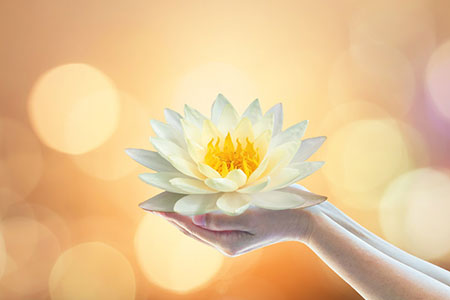spiritual insight
The Power And Beauty Of Your Inner Divine Light
 A friend recently asked me to help her hang a new chandelier. And reluctantly, I agreed to give up my treasured Sunday evening movie time to help with the project.
A friend recently asked me to help her hang a new chandelier. And reluctantly, I agreed to give up my treasured Sunday evening movie time to help with the project.
Arriving at her house, I found her with a very heavy box nearly five feet tall. At first, I could not fathom the actual size and shape of the chandelier hidden beneath the layers of packaging and thick pieces of unyielding plywood and cardboard.
I was surprised to eventually find what seemed like a chaotic mess of tangled wires affixed to hundreds of tiny quartz crystals. Could it be a warehouse or shipping mishap, I wondered?
I stepped back and took a deep breath, asking myself if I had maybe taken on more than can handle. But before I could speculate any further, my friend proceeded to life up the chandelier to allow each of the seemingly coiled wires to gently fall into place!
I was amazed at how something that appeared so entangled and messy one moment, could suddenly transform into this breathtaking spectacle of sparkling light. Then we added the large quartz stones for the ends to complete the fixture, and soon it was hanging in my friend’s dining room. And I stood back in awe of its magnificent beauty. I was speechless.
This experience reminded me of those times in life when everything seems to be upside down and off-kilter. Those unexpected situations that render us temporarily overwhelmed. I have no shame in admitting that I have succumbed to feeling somewhat defeated in moments like that.
But what I have also learned with the guidance of Spirit is there is always the opportunity in our lives to transform with just a little bit of courage and perseverance a seemingly messy dilemma into something positive and beautiful. No matter how difficult a situation might appear, there is always a silver lining. Continue reading
Transform Your Life With Daily Spiritual Power
 If you are seeking change in your life, you must create the change. You alone create your reality. Your future happiness, joy and fulfillment does not depend on others. It truly depends on you, and you only. But it is not necessary for you to plan or control exactly how everything will change or work out. Leave the ultimate manifestation and transformation to Spirit and the Divine. But you must at least believe your life can change, and will change. And the best way to ensure such transformational changes in your life is to spiritual practice a part of your daily lifestyle.
If you are seeking change in your life, you must create the change. You alone create your reality. Your future happiness, joy and fulfillment does not depend on others. It truly depends on you, and you only. But it is not necessary for you to plan or control exactly how everything will change or work out. Leave the ultimate manifestation and transformation to Spirit and the Divine. But you must at least believe your life can change, and will change. And the best way to ensure such transformational changes in your life is to spiritual practice a part of your daily lifestyle.
My daily routine, which rarely changes, includes the following spiritual practices. Upon awakening I immediately do my affirmation prayer for the day.
Thank you, Universe for this amazing, positive, successful, and abundant day ahead of me. I know it will be better than yesterday and I am ready!
Thank you, Archangel Michael for putting your cloak of protection around me, from above my head to below my feet. May it shield me from all negative energy and bounce it back in to the ethers, instead of attaching itself to me during my day.
I also ask this for my partner, children and grandchildren. Amen.
After my prayer, I am grounded and centered to confidently go about my daily business. Even if I have nothing major going on, I will still get dressed as if I have something important to do that day. This further ‘lifts my energy,’ because as I look in the mirror and I feel prepared anything. I know I am going to be successful, happy and in a good place for the day.
One I am turned-out for the day, and before I start working, I sit at my desk and study at least one chapter in a spiritual book, as I need this knowledge every day in my work with my clients all over the world. Some of my favorite inspirational sources to date are Psycho-Cybernetics by Maxwell Maltz; You2 by Price Pritchett; The Power of Awareness by Neville Goddard; You Can Heal Your Life by Louise Hay; and The Four Agreements by Don Miguel Ruiz. But I have many others in my personal library.
The Lotus Flower Reading
 I recently attended an online psychic development workshop. In one of the tasks, we had to partner with another student and do a ‘flower reading.’ I know touching an object using psychometry works well in readings, but this is something else.
I recently attended an online psychic development workshop. In one of the tasks, we had to partner with another student and do a ‘flower reading.’ I know touching an object using psychometry works well in readings, but this is something else.
Our teacher paired us up and we didn’t know in advance with whom. We also had to intuitively pick a flower for our partner beforehand. At the beginning of the session, we had to show the other person the actual flower or a color photo of the flower we had chosen for them on our shared screens.
In preparation for this, I placed many pieces of paper, each with the name of a different flower on it, into a bag, shook it up, and drew one. Spirit guided me to select the Indian lotus flower or nelumbo nucifera.
When it was my turn to read for my classmate, I relaxed and observed the image of the lovely white lotus in front of me. The depth of information that came forth in the reading about her past, how her life was now, and what lay ahead, was truly amazing!
The reading revealed that she was going to be blossoming soon like the lotus, because she currently finds herself in a strong development stage. I later learned that she’d been through some dark times, almost giving up on herself. She had recently begun doing deep shadow work, as well as exploring her psychic development.
She is also recovering from a recent trauma and the lotus is traditionally known for being the ideal gift for someone recovering from any traumatic experience or physical injury. Many years ago, I attended a Yoga class during which the challenges of the lotus position was discussed in-depth. The teacher said that through proper breathwork and becoming more flexible, one’s body will allow you to achieve this pose.
I was only 19 years old at the time and not very supple. I saw no hope of achieving that position for quite some time. However, only a few classes later, we did a session during which a lot of emphasis was placed on our breathing. And to my amazement, I was able to easily get into the lotus position!
Questions That Truly Satisfy The Self
 Once upon the ages, over 5,000 years ago, the world’s great saints, sages, and spiritual scholars assembled at a place called Naimisharanya. This sacred forest was known to them as the energetic hub of the Universe, from where the benefits of their practices, sacrifices, and speech would extend to all the world’s inhabitants. Thus, they gathered here specifically with the intention of welfare for every living being.
Once upon the ages, over 5,000 years ago, the world’s great saints, sages, and spiritual scholars assembled at a place called Naimisharanya. This sacred forest was known to them as the energetic hub of the Universe, from where the benefits of their practices, sacrifices, and speech would extend to all the world’s inhabitants. Thus, they gathered here specifically with the intention of welfare for every living being.
By dint of their self-realization, these wise seers were gifted with foresight of the Age of Quarrel in which we now live. They considered that humans of this time would be short-lived and plagued by various mental, bodily, and natural disturbances. So, they contemplated what they could do to bring relief and the highest good for all in the many generations to follow.
They selected Suta Goswami as the most elevated among them, offered him a seat of esteem, and inquired from him with great respect. Because Suta Goswami was free from vice, learned in all scriptures and teachings of physical, metaphysical, and spiritual knowledge, and properly guided by the great masters, who had gone before him, the sages regarded him as most qualified to enlighten them about the Supreme Truth. Therefore, they humbly approached him with inquiries toward that end.
The sages began with six questions which they had ascertained to be of primary importance:
1. What is the absolute and ultimate good for people in general?
2. What is the essence of all scriptures and prescribed practices, by which the hearts of every living entity may be fully satisfied?


